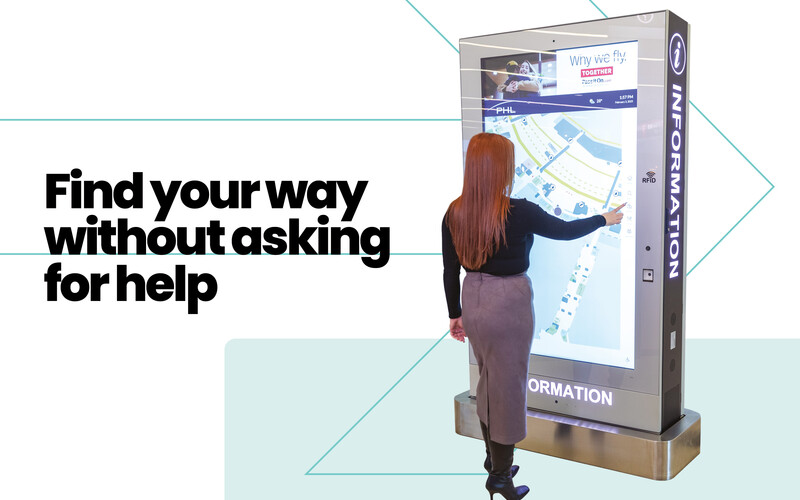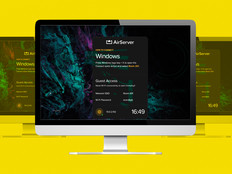As the host of six matches over three summer weeks for soccer’s 2026 FIFA World Cup, Philadelphia is anticipating an influx of more than half a million visitors to the city. Also on the city’s agenda for that year and expected to draw hundreds of thousands are the NCAA’s March Madness men’s basketball tournament, MLB’s All-Star Game and various events celebrating the 250th anniversary of the signing of the Declaration of Independence.
“It’s going to be a busy year,” says Allen Mehta, CIO for the Philadelphia Department of Aviation, which owns and operates the Philadelphia International Airport. “Here at the airport, we’re going to be the hub. We’ll need to make sure that travelers can get to their destinations as efficiently as possible.”
With that in mind, PHL has been investing in new wayfinding signage meant to help people navigate everything from its parking garages to its 3 million square feet of terminal space. In total, there are now about 1,500 digital displays strategically spaced around the airport property, “but that number could triple moving forward as we look at changing out static signs for dynamic ones,” Mehta says.
Click the banner to prepare for transformational government.
Funds allotted to airports through the federal Infrastructure Investment and Jobs Act of 2021 are a key driver of digital signage implementations. The statute provides $25 billion for a variety of air transportation projects, including terminal modernization, says Bonnie Powell, a researcher with the National Renewable Energy Laboratory and lead author of the report “The Evolution of Wayfinding Within Airports.”
“Wayfinding solutions are evolving quickly,” Powell says. Signs can incorporate technologies such as augmented reality or change languages based on scheduled flights. “If a plane from China just arrived, maybe signage will show wayfinding information in Chinese to make it easier for those passengers to get through the airport,” she explains.
“Right now, we’re at the stage where a lot of airports are testing technologies to see what works and what travelers like,” Powell says. “In the future, we’re going to see design simplifications that make wayfinding more intuitive.”
RELATED: Innovative municipalities deploy augmented reality for wayfinding.
Airport Digital Signage Keeps Travelers Informed
In Philadelphia, airport wayfinding devices come from several different vendors, including Sony, Samsung, Tripp Lite and Dell. For now, they’re managed by staff through more than 900 media players operated via Mac or PC; by 2026, the controllers will be replaced by a single, airportwide content management system.
Mehta says that adopting digital signage became a priority for PHL when the pandemic led to travelers seeking to minimize face-to-face interactions. Many were also frustrated by what they perceived to be excessively long wait times in check-in and security lines.
“We put in our first dynamic signage at our TSA checkpoints to help reduce the stress,” he says. “You’d see that your line was really only going to take 15 minutes, or maybe 3 minutes through TSA PreCheck.”
On large displays, airport maps show where travelers can find restaurants and shopping. Constantly updated monitors help airline passengers get around with as much or as little human assistance as they choose. Monitors offering directions to bathrooms indicate when a facility is temporarily closed for cleaning and suggest nearby alternatives, for example.
These displays support the smooth flow of tens of millions of people a year in individual airports.
For those who prefer to get directions from real people, experienced staff are also ready to help, says Camille Tomlin, PHL vice president of IT systems and infrastructure. “But if you just want to check in and get to your gate” — or get out of the airport to get to the game — “everything you need to find your way around is going to be on those screens.”
28M
The approximate number of passengers who traveled through Philadelphia International Airport in 2023
Source: phl.org, “PHL Welcomed 28.1 Million Passengers in 2023,” Feb. 12, 2024
Wayfinding Produces a Pleasant Traveler Experience
Finding new ways to simplify wayfinding is part of the modernization plan at Hartsfield-Jackson Atlanta International Airport. The busiest airport in the world, ATL is currently replacing much of its static signage with digital wayfinding technology.
“The idea is that it’s better for everyone when we can change a display for the circumstances at hand,” says Charles Pettis, the airport’s director of customer experience. Digital signage is a way to give travelers useful, up-to-date information.
“Knowledge eases anxiety for people; it makes navigating the airport a little more pleasant,” he adds.
Pettis says that digital wayfinding technologies can also cut down on signage congestion. Where once an airport may have needed three signs to convey three different directional messages, it now can deploy a single digital display that cycles through those messages.
Today, ATL’s signage includes LED and LCD displays and video walls from manufacturers such as Leyard and Planar. Signs advertising Atlanta destinations ensure that travelers who are visiting the city know where to go when they exit the airport, while others display flight information or direct passengers to security screening.
Pettis notes that his job requires him to “understand the voice” of customers, and most travelers simply want an uncomplicated airport journey. If a gate has been changed, that doesn’t really matter as long as it’s clear how to get to the new one. Standing in line becomes easier when there are signs indicating how long the wait will be.
Wayfinding technology is a way for the airport to meet travelers where they are, Pettis says.
ATL is “interested in the entire traveler journey, from the time they head to the airport through ticketing, security, their departure and their return,” he says. Digital signage puts timely messages front and center, where they’re needed. “It does what we want it to do: make a positive impact on the passenger experience.”
DISCOVER: Cybersecurity vendors help airports defense against bad actors.
How Wayfinding Evolves to Manage Foot Traffic
Anyone who’s flown in the past decade knows how a well-placed wayfinding display can impact the travel experience. But displays are also important to airports themselves, which have a vested interest in moving people effectively.
At Harry Reid International Airport in Las Vegas, for example, 31 multi-touch interactive directories support “key business objectives,” says Rishma Khimji, chief IT officer with the Clark County Department of Aviation.
These include optimizing traffic flow, enhancing customer satisfaction and reducing traveler reliance on staff to answer navigation-related questions. The screens leverage a unified wayfinding system across social media platforms, airline applications and the airport’s website, she says, and “improve operational efficiency and boost revenue by encouraging exploration and making spaces more user-friendly.”
UP NEXT: AI is transforming the citizen experience.















